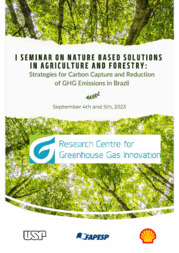Nitrous oxide and methane emissions from soil under pasture fertilized with nitrogentrous oxide and methane emissions from soil under pasture fertilized with nitrogen.
Nitrous oxide and methane emissions from soil under pasture fertilized with nitrogentrous oxide and methane emissions from soil under pasture fertilized with nitrogen.
Autoria: PENTEADO, L. F.; NOGUEIRA, S. F.; MOLINA, R. F.; DEUS, I. D. de; BARBOSA, C. M. P.; ANDRADE, C. A. de
Resumo: The contemporary global development model has been changing in order to reconcile productivity and sustainability. Harmonizing the environment and production fundamentally depends on the development and adoption of conservationist and sustainable agricultural practices. Livestock accounts for more than 60% of GHG emissions from the agricultural sector in Brazil, while nitrogen fertilization accounts for 35%, which are important aspects for promoting actions to reduce national emissions. The study will be divided into two parts: one in the field and another in the laboratory. In the field experiment, four nitrogen fertilization rates will be evaluated (0, 75, 150 e 300 kg N.ha-1 , in addition to a treatment with a dose of 150 kg N.ha-1 split (50+100 kg N.ha-1 ), regarding GHG emissions. The source of N will be ammonium nitrate, used in experimental plots of 14 x 14 m, with established pasture of Urochloa brizantha cv. Marandu. GHG emissions will be monitored using static chambers and periodic sampling after fertilization, until fluxes stabilize. The collected samples will be analyzed by gas chromatography. Next, the daily flows will be integrated and the data will be processed in order to verify the effect of N rates and split of fertilization on N2O flows and emission factor of this gas and the effect on CH4 emissions or consumption. For the laboratory research, 12 sources of N will be incubated with soil, under potentially favorable conditions for N2O emission (temperature of 28oC and soil moisture corresponding to 80% of the total pores filled with water). Nitrogen sources will include animal excreta (urine and feces), conventional mineral fertilizers, use of inhibitors and slow-release fertilizers. For about 90 days or until the gas flows stabilize, N2O and CH4 will be monitored. It is expected that the results generated in the research will be incorporated into the literature that supports more regionalized and customized N2O emission factors, contributing to the improvement of emission inventories and to the carbon accounting of livestock production systems.
Ano de publicação: 2023
Tipo de publicação: Resumo em anais e proceedings
Unidade: Embrapa Meio Ambiente
Palavras-chave: Carbon footprint, Carbono, Climate change, Greenhouse gases, Mudança Climática, Nitrogênio, Nitrous oxide, Pastagem
Observações
1 - Por padrão são exibidas publicações dos últimos 20 anos. Para encontrar publicações mais antigas, configure o filtro ano de publicação, colocando o ano a partir do qual você deseja encontrar publicações. O filtro está na coluna da esquerda na busca acima.
2 - Para ler algumas publicações da Embrapa (apenas as que estão em formato ePub), é necessário ter, no celular ou computador, um desses softwares gratuitos. Sistemas Android: Google Play Livros; IOS: iBooks; Windows e Linux: software Calibre.
Acesse outras publicações
Acesse a Base de Dados da Pesquisa Agropecuária (BDPA) para consultar o acervo completo das bibliotecas da Embrapa.

